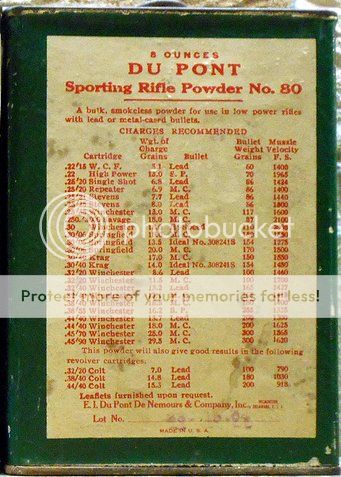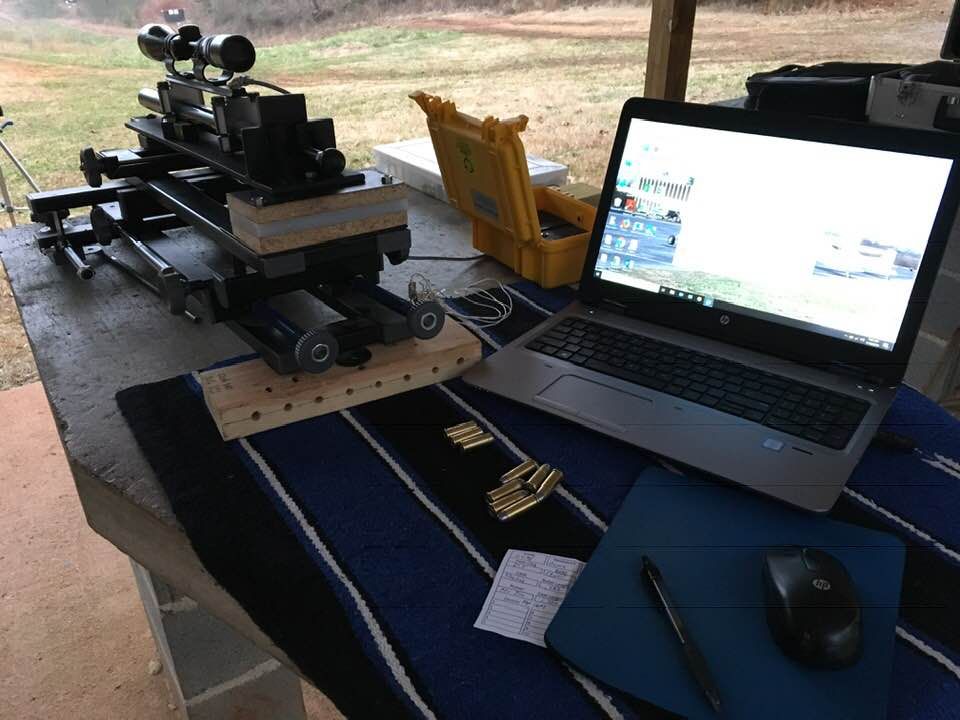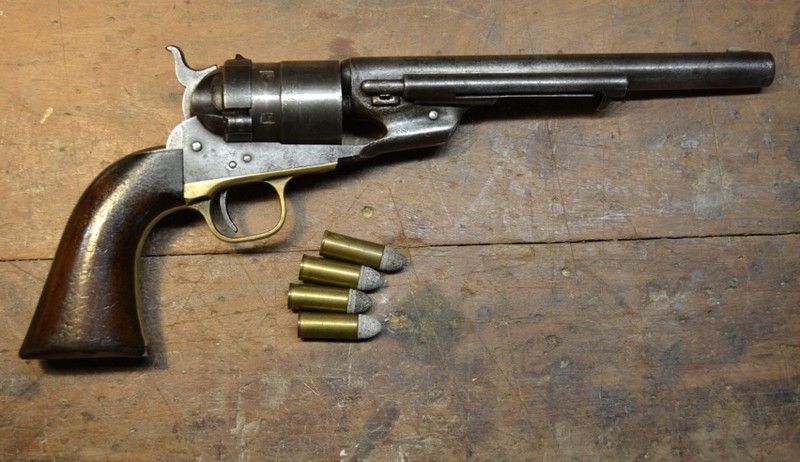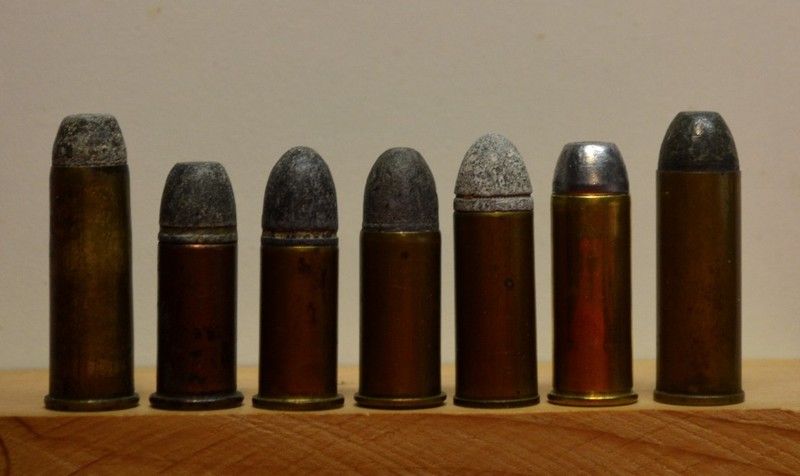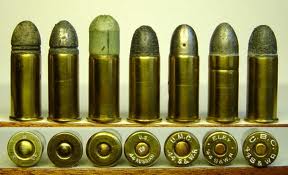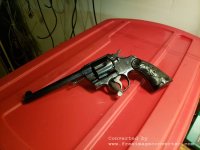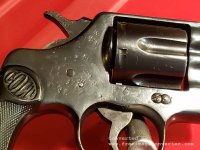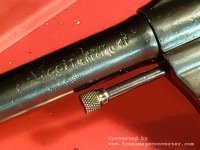Now that I have my notes...
44-40 Revolver
A while back I was able to get 40gr by weight of Swiss FFG into some RP brass with a .21" compression without any case distortion using RP brass. RP brass is thicker and less likely to expand with the compressed powder. I modified a bullet seating die to compress the powder. I used Dick Dasterdly's Big Lube bullet but the skirt is only a tad shorter than the 427098. According to my notes I achieved an average velocity of
960fps/409ft lbs of energy out of my 5.5" Uberti SA revolver....940fps with 38gr of Swiss FFG.
44-40 Rifle
Using a compressed load 40gr/weight of Swiss FFG and a Accurate mold 43-210B (Lyman 427098 replica with larger lube groove), I achieved 1,365fps out of my original 24" barreled 1989 Marlin manufactured in 1891.
45 Colt
Using 38.4gr of Goex FFFG and a Lyman 250gr 454190, I achieved
1,104fps/676ft lbs of energy out of my 5.5" barreled Uberti SA revolver. Using a lighter military type load....250gr Lyman 454190 and 36gr of Goex FFFG (some used less), I achieved
785fps/342ft lbs of energy.
By October 1873, Frankford Arsenal was manufacturing Benet-primed cased 45 Colt cartridges that were loaded with only 30gr of black powder with the 250gr bullet. This was due to 40gr being to much power for the early weak copper cases. By July of 1874, Frankford phased out the longer cases 45 and was solely manufacturing the shorter cased 230gr 45 Schofield cartridges used in both of the Armys 45 Colt and 45 Schofield revolvers with only 28gr of black powder. The cartridge boxes were not designated which was which but only listed the bullet type and amount of powder used. I have yet to make some replica loads but you can only imagine how much less they would be in power and energy.
Civilian world...45 Colt
I don't have any information on civilian offered cartridges at this early stage.
Thus until sometime after the 45 Colt cartridges used the improved brass center-fire cartridges, the 44WCF was actually more powerful than the 45 Colt. I have never loaded my 45 Colt revolvers with smokeless powders for a faster load than that I described by using black powder. Using smokeless powders, I have only achieved in the low 900fps velocity ranges.
44-40 Hot Loads
Using a 7.5" magnum frame SAA revolver with thicker walled cylinders...and using published hot "Group II" rifle loads from Lyman's 49th..., I have achieved over 1,200fps using hot 44-40 loads that should never ever be used in standard SAA or weak action rifles like the Winchester 73'.
Using a nice load of Reloder 7 and a 21gr Sierra JHC, I achieved 1,403fps in my Marlin 1894CB and grouped shots in a 4" circle at 100 yards. Also using a nice load of Reloder 7 and a 240gr SWC [1,373fps] and the Marlin, I grouped 20 shots in a 4" circle at 100 yards.
For cowboy action shooting, I used 38gr black powder or 6.4gr of Trailboss.
https://www.44winchestercenterfirecartridges.com/
Since my posting of that reply I have conducted some Pressuretrace II testing with black powder loads for the 44-40. The results were not expected but make sense and continue to answer my questions.
Swiss FFG closely replicated early BP powders and is superior to other modern brands.
I filled modern brass with 40gr by weight of Swiss FFG. This powder is by far the most dense of any black powder on the market. 40gr by weight equaled 40gr by volume with this particular batch. The powder was tap settled then compressed to .19" to .21" with a powder compression die. A Lyman handcast 427098 bullet was inserted and crimped just below the top of forward driving band, sitting firmly on top of the powder. WLP's were used in Starline cases. A 20 shot group from my 20" MGM barrel test stand resulted in 1,240fps @ 8,800psi
The same load was used in 1880's original unheadstamped semi-balloonhead cases resulting in 1,373fps @ 14,285psi
The same load was used again in both style brass cases but this time using Goex FFFG. Goex is less dense so 40gr weight required a minimum of .22" compression in modern brass. Again the results were consistent.
Original Unheadstamped semi-balloonhead cases produced 1,356fps @ 12,648psi
Original REM-UMC headstamped semi-balloonhead cases produced 1,248fps @ 10,037psi
Original WRA headstamped semi-balloonhead cases produced 1,272fps @ 11,001psi
Original Western headstamped semi-balloonhead cases produced 1,276fps @ 12,755psi
Original black powder 44-40 cartridges were far more superior than today's tyipical BP AND smokeless loads. Dissected cartridges by me and the late John Kort showed 40gr by weight of a sporting type powder...grains suggesting a mixture of FF and FFF. John Kort took original cartridges, replaced the dead primers and shot them. His results were at times 1,400fps on cases not dissected and 1,370's in cases he dissected. He explains how he replaced dead primes in cases not dissected.....by first saying "don't try this at home".
The old timers that fully understood first hand the potency of the "pre-war" cartridges are long dead....only to be followed by myths and misconceptions by the next generations. Old timers, (I am 52), that have been handloading the 44-40 for the past 50 years have no clue as to the true history of the 44-40 cartridge. Their postings prove it.
"Twenty two years after its introduction, the first .44 W.C.F. smokeless powder cartridge is found in Winchester's catalog No. 55, dated August, 1895. In its manufacture, Winchester used 17 grains of DuPont No. 2 which was a "bulk" type smokeless powder patented on August 22, 1893. DuPont's description of "bulk" smokeless powder indicated that it was to be loaded in "bulk" measure just like black powder.
In the .44 W.C.F., 17 grs. of DuPont No. 2 Bulk Smokeless occupied the same volume as 40 grs. of FFG. Velocity was cataloged at 1,300 f.p.s. for a 55 f.p.s. increase over the the black powder cartridge. To identify the new .44 W.C.F. smokeless powder cartridges from those containing black powder, which looked identical, Winchester put a "W" in a circle on the primer." Dupont #2 had a similar burn rate as today's IMR-4227. However, Unlike 17gr of Dupont #2, 17gr of IMR-4227 is not a case capacity load but is a published load. Also unlike Dupont #2, IMR-4227 is formulated in a way thatt retards burning which prevents high pressure spikes.
Lyman's 49th lists a max load, 17gr of IMR-4227 with a Lyman 427098. They claim 1,083fps with no pressure listed for Group I rifles like the Winchester 73'. I tested 17gr in my 20" MGM barrel I used for high pressure testing. 17gr with a 427098 resulted in 1,127fps (closely replicating modern Winchester Super-X ammo velocity) @ 9,500psi. I tested 20gr with a 43-215C (427098 replica) resulted in 1,418fps @ 16,500psi but also included .5cc of PSB shot buffer to keep the powder at the back of the case. IMR-4227 is position sensitive and could be why some of my early velocity tests were lower than the manual.
Lyman's 49th handloading manual shows a max load of 18.5gr of IMR-4227 with a Speer JHP@ 1,212fps. This load only gave me 1,097fps. 20gr of IMR-4227 produced 1,297fps but also created 12,000psi, just a tad over the 11,000psi max. A caseload (26gr) of IMR-4227 with the popular Magma type 200gr lead bullet resulted in 1,733fps but produced 20,913psi....only safe for Group II rifles like the Winchester 92/94 and Marlin's 1894. I am getting consistent 10 shot 4" groups at 100 yards.
22gr with a Winchester 200gr JSP (.425) produced 1,386fps at a lower 12,000psi, which closely replicated early Dupont #2 velocities. I also tested black powder loads in semi-balloon head cases and got a consistent 12,000psi, so I feel safe using 12,000psi loads in my Winchester 73 replica and revolvers with .425-.427 lead or jacketed bullets.
Because of my black powder results using semi-balloonhead cases, I am beginning to think that original BP and smokeless factory loads produced a consistent 12,000psi to 13,000psi. I have yet to see original factory data other than 22,000cup for the High Velocity loads that produced 1,500fps. It would appear that Dupont #2 powder was not coated with a flame-deterrent coating that would retard burning thus causing high pressure spikes and may be why Winchester advertised their new smokeless powder ammunition to NOT be used in revolvers...referring to those black powder frame revolvers.
"Dupont #2 was patented in 1893 and was sold under the "Deer Banner" not as No. 2. It was a semi-bulk powder and not very popular compared to No. 1 or Shotgun Bulk." ~RicinYakima
By the early 1900's, Sharpshooter replaced Dupont #2.
much information by John Kort reiterated....
Unlike Dupont #2, L&R Sharpshooter was specifically used in black powder frame firearms. I assume this must be because of the addition of the flame-deterrent coatings that would retard burning allowing lower pressure curves even lower than black powder. In 1903 the High Velocity .44-40 cartridge was introduced. It to used "Sharpshooter" powder in larger doses to achieve its 1,570 f.p.s. velocity. They were discontinued by the mid 1940's.
In 1913, DuPont introduced SR80 (Sporting Rifle) . It was a granular type powder, similar in appearance to DuPont No.2 Bulk Smokeless but was a bit faster burning and was not a "bulk" type powder. It's burning rate was in the same range as "Sharpshooter".
“Sharpshooter” and "SR80" fueled millions of .44-40 smokeless factory cartridges up until at least the 1950’s (SR80 was discontinued in 1939) when ball powders began appearing on the scene. Winchester switched to a ball powder similar to the old W630 which also has a similar burning rate to 2400. Remington continued to use “Sharpshooter”.
During all that time,factory ballistics for the standard cartridge remained at 1,300 f.p.s. with a 200 gr. jacketed bullet.
John had the opportunity to find and shoot cartridges of the period and they equaled and sometimes slightly exceeded the 1,300 f.p.s. cataloged velocity.
By the early 1970’s, factory ballistics had been reduced to 1,190 f.p.s. in the catalogs. The reason? It would appear faster burning powders in smaller 7 to 8 gr doses had replaced the slower burning powders. Thus, to keep the pressures within the specified SAAMI limits for the .44-40, the velocity was reduced. I still do not know what the early pressure were for the 44-40. Again my testings found that some black powder loads in early semi-balloonhead case produces 12,000psi to 14,000psi pending which powder I used. I used Swiss FFG and Goex FFFg, Swiss being the hottest.
Unlike the earlier smokeless cartridges that produced catalog ballistics, John also found that in testing the current Winchester and Remington JSP cartridges, they fell a bit short of the 1,190 f.p.s.specification ( closer to 1,150 f.p.s. average). My testing resulted in a consistent 1,050fps @ 8,000psi. Most of my factory smokeless powder testings resulted in pressures 10%-20% lower than SAAMI MAP.
By the 1990’s a new class of 44-40 cartridges were introduced called “Cowboy”. This was due to the interest in Cowboy Action Shooting. Bullets were lead or lead alloy going at around 900-1000 f.p.s.(rifle). Ballistics are 30+% reduced from the original smokeless (and black powder) cartridge and are just fine for recreational shooting. Time after time I see new comers commenting on how much the 44-40 is not as powerful as they thought, how they don't like it....mainly after shooting factory cowboy loads and thinking that these loads are normal loads. Factory Winchester Super-X hunting loads are not even normal. Soon to, these generations of 44-40 shooters will continue to hand down false information on how the 44-40 is only good for pinking....failing to understand just how much of an importance of a roll the .44 and .44WCF played in 200 yard kills at The Battle of the Little Bighorn.
Early Smokeless Powder was sold in Kegs just like black powder. The kegs came in various sizes...some not much bigger than a can of beans.
Sharpshooter was developed by Laflin & Rand, then offered by DuPont after they purchased L&R. Hercules produced it from 1912 on. It was a very flexible powder and after about 1900, was THE powder that was used in most all the b.p. cartridge factory smokeless loadings including the H.V., H.P. and W.H.V. (High Velocity) cartridges. It was used right up to the 1950's, after which it was discontinued.
Ever since, the 44-40 has been neutered and since most old timers that have been handloading the 44-40 for the past 50 years...were born in 1945 or later........well....now you know the rest of the story.
